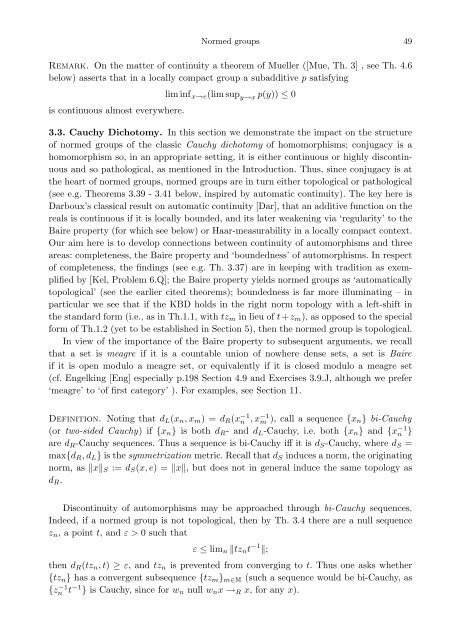Normed versus topological groups: Dichotomy and duality
Normed versus topological groups: Dichotomy and duality
Normed versus topological groups: Dichotomy and duality
Create successful ePaper yourself
Turn your PDF publications into a flip-book with our unique Google optimized e-Paper software.
<strong>Normed</strong> <strong>groups</strong> 49Remark. On the matter of continuity a theorem of Mueller ([Mue, Th. 3] , see Th. 4.6below) asserts that in a locally compact group a subadditive p satisfyingis continuous almost everywhere.lim inf x→e (lim sup y→x p(y)) ≤ 03.3. Cauchy <strong>Dichotomy</strong>. In this section we demonstrate the impact on the structureof normed <strong>groups</strong> of the classic Cauchy dichotomy of homomorphisms; conjugacy is ahomomorphism so, in an appropriate setting, it is either continuous or highly discontinuous<strong>and</strong> so pathological, as mentioned in the Introduction. Thus, since conjugacy is atthe heart of normed <strong>groups</strong>, normed <strong>groups</strong> are in turn either <strong>topological</strong> or pathological(see e.g. Theorems 3.39 - 3.41 below, inspired by automatic continuity). The key here isDarboux’s classical result on automatic continuity [Dar], that an additive function on thereals is continuous if it is locally bounded, <strong>and</strong> its later weakening via ‘regularity’ to theBaire property (for which see below) or Haar-measurability in a locally compact context.Our aim here is to develop connections between continuity of automorphisms <strong>and</strong> threeareas: completeness, the Baire property <strong>and</strong> ‘boundedness’ of automorphisms. In respectof completeness, the findings (see e.g. Th. 3.37) are in keeping with tradition as exemplifiedby [Kel, Problem 6.Q]; the Baire property yields normed <strong>groups</strong> as ‘automatically<strong>topological</strong>’ (see the earlier cited theorems); boundedness is far more illuminating – inparticular we see that if the KBD holds in the right norm topology with a left-shift inthe st<strong>and</strong>ard form (i.e., as in Th.1.1, with tz m in lieu of t +z m ), as opposed to the specialform of Th.1.2 (yet to be established in Section 5), then the normed group is <strong>topological</strong>.In view of the importance of the Baire property to subsequent arguments, we recallthat a set is meagre if it is a countable union of nowhere dense sets, a set is Baireif it is open modulo a meagre set, or equivalently if it is closed modulo a meagre set(cf. Engelking [Eng] especially p.198 Section 4.9 <strong>and</strong> Exercises 3.9.J, although we prefer‘meagre’ to ‘of first category’ ). For examples, see Section 11.Definition. Noting that d L (x n , x m ) = d R (x −1n , x −1m ), call a sequence {x n } bi-Cauchy(or two-sided Cauchy) if {x n } is both d R - <strong>and</strong> d L -Cauchy, i.e. both {x n } <strong>and</strong> {x −1n }are d R -Cauchy sequences. Thus a sequence is bi-Cauchy iff it is d S -Cauchy, where d S =max{d R , d L } is the symmetrization metric. Recall that d S induces a norm, the originatingnorm, as ‖x‖ S := d S (x, e) = ‖x‖, but does not in general induce the same topology asd R .Discontinuity of automorphisms may be approached through bi-Cauchy sequences.Indeed, if a normed group is not <strong>topological</strong>, then by Th. 3.4 there are a null sequencez n , a point t, <strong>and</strong> ε > 0 such thatε ≤ lim n ‖tz n t −1 ‖;then d R (tz n , t) ≥ ε, <strong>and</strong> tz n is prevented from converging to t. Thus one asks whether{tz n } has a convergent subsequence {tz m } m∈M (such a sequence would be bi-Cauchy, ast −1 } is Cauchy, since for w n null w n x → R x, for any x).{z −1n
















